
Related
Guests
- Nick Estesassistant professor of American studies at the University of New Mexico and author of the new book, Our History Is the Future. He is a co-founder of the indigenous resistance group The Red Nation and a citizen of the Lower Brule Sioux Tribe.
As Nebraska and the U.S. Midwest recover from devastating climate change-fueled floods, we speak with Lakota historian Nick Estes on how two centuries of indigenous resistance created the movement proclaiming “Water is life.” Estes’s new book is titled “Our History Is the Future.” He is a co-founder of the indigenous resistance group The Red Nation and a citizen of the Lower Brule Sioux Tribe.
Transcript
AMY GOODMAN: This is Democracy Now! I’m Amy Goodman. While the Southern Hemisphere faces its worst tropical cyclone on record, states across the Midwestern United States are continuing to recover from unprecedented flooding this week that devastated communities in Missouri, Iowa, Kansas, and particularly Nebraska. Warming temperatures, snow melt and heavy rainfall led to a flash flood that overwhelmed the Missouri River. The rising waters breached levees, killing at least four people, destroying or damaging thousands of homes.
Much of the news about the flooding has focused its impact on farmers. But the climate-changed fueled weather has also hit Native American communities hard, with four tribal nations in Nebraska declaring a state of emergency. This is Larry Wright Jr., chair of the Ponca Tribe of Nebraska, speaking last week.
LARRY WRIGHT JR: Today I have declared a state of emergency for the Ponca Tribe in Nebraska in our territory, as it relates to our homeland, in Niobrara, as well as our communities in Norfolk and Sioux City. And we’ll continue to monitor the situation, as we move forward, with the flooding.
AMY GOODMAN: Scientists warn that more flooding is on the way as climate change-fueled extreme weather patterns around the planet. Santee Sioux Chairman Roger Trudell, whose tribe faced unprecedented flooding in Nebraska, told Earther, quote, “I’m just sorry that our national leaders, the people with the power to do something about it, just put their head in the sand and pretend that there’s no such thing as climate change or global warming or anything when it’s so evident. They should be ashamed of themselves,” he said.
For more, we go to Santa Fe, New Mexico, where we’re joined by a Lakota historian who says that the history of indigenous resistance can offer a road map for collective liberation and a guide to fighting life-threatening climate change. In his new book, Our History Is the Future, Nick Estes tracks how two centuries of indigenous resistance created the movement at Standing Rock proclaiming “Water is life.” Estes is assistant professor of American studies at University of New Mexico, co-founder of the indigenous resistance group The Red Nation. He is a citizen of the Lower Brule Sioux Tribe.
Professor Estes, welcome to Democracy Now! Can you respond to what’s happened in the Midwest, from Nebraska on, and particularly talk about the effects on Native Americans?
NICK ESTES: Right. So, this history of flooding actually goes back to the 1930s, when the Missouri River flooded and flooded a lot of towns downriver. And the United States government, under the auspices of the Green Deal—or, excuse me, the New Deal, proposed a series of earthen-rolled dams on the main stem of the river to prevent flooding downriver in places, like Kansas, that are experiencing flooding right now. And so, in places like Lower Brule, where I’m from, they built the Big Bend Dam, and then, upriver from there, they built the Oahe Dam, to have sort of flood control for downriver states. And so what we’re seeing right now is just a continuation of the mismanagement of that river, and the flooding that’s being caused specifically by the Army Corps of Engineers. These dams dislocated and forcefully removed about a third of our river reservation populations, including my own community. In places like Fort Berthold, about 80 percent of the tribal population was removed.
And so, what we’re experiencing right now is a continuation of the legacy of the Pick-Sloan dams that were built to prevent this kind of disaster. And so, in many ways, you know, we have a compounding of issues, with the unusual weather cycles, the torrential rain, and then couple that with the fact that the government shutdown for 35 days, preventing a lot of tribal communities, that are now affected by this flood, from getting heating assistance during the wintertime. And so, it’s a combination of things that are at work here. And at the end of the day, we have to remember that while it is related to climate change in the present, it’s also related to the altering of the environment, and specifically the annihilation of the river ecosystem to provide sort of flood control in the first place.
AMY GOODMAN: Nick Estes, you’re talking about the New Deal, back in FDR’s time. You say the Green New Deal really was borne out of the standoff at Standing Rock. Explain.
NICK ESTES: So, Alexandria Ocasio-Cortez, before she became a congresswoman, she was also—she was a water protector. She was at Standing Rock—and she’s even said this in her interviews—where she began her campaign in the resistance camps, in the prayer camps at Standing Rock, and specifically Oceti Sakowin Camp. And so, when people are asking, you know, “Where’s the inspiration of the Green New Deal?” we can really locate it at Standing Rock, where you had sort of the transition from one administration, the Obama administration, to the Trump administration.
And I believe Ocasio-Cortez was at Standing Rock after November 8th, 2016, when the election of Trump really caught a lot of people by surprise. And the irony of that was, you know, there was a massive resistance movement against the construction and the expansion of carbon infrastructure, led by indigenous people at Standing Rock. But, in reality, that pipeline was an extension of Obama-era energy policies. And so, if we go back to 2007 and 2008 and look at the North American oil boom, that really happened around the time of the Great Recession. And so, in many ways, the United States, along with countries like Canada, drilled their way out of the Great Recession, largely at the expense of indigenous lands.
And what I mean by that is, if we look at the oil sands in Alberta, Canada, and we think about the Dakota Access pipeline, which indigenous people, my people, the Lakota people, call the “black snake,” the Alberta tar sands is really the snake pit, where a lot of these oil pipelines are snaking out across the country, you know, and specifically traversing and trespassing through indigenous communities and putting them at risk.
And so, when we think about things such as the Green New Deal and their impact on indigenous communities, we have to remember that the inspiration for that, and really the front-line communities that inspired this, were communities like Standing Rock and indigenous communities, not just in the United States, but throughout North America, or what we call Turtle Island. And so, when we talk about what’s happening, you know, the flooding, the massive flooding that’s happening in places like southeastern Africa, we can connect it to the oil production in the United States and in North America, in general, because the United States has now surpassed countries like Russia and Saudi Arabia when it comes to oil production. And we can look at places like the Bakken oil region, where the Dakota Access pipeline was originating from, as sort of being sort of ground zero for this new sort of climate deal that needs to take place, because it affects indigenous communities, first and foremost.
AMY GOODMAN: Nick, explain your title, Our History Is the Future.
NICK ESTES: So, that has two meanings. The first meaning is sort of a negative meaning, in the sense that the Oceti Sakowin, the Great Sioux Nation, has undergone several apocalypses. Going back to the fur trade and the annihilation of fur-bearing animals in our region, going back to the annihilation of the buffalo to take the land and to starve us into surrender, going back to the mid-20th century damming of the Missouri River, and now the North American sort of oil boom, these are different rounds of dispossession that we see in a long continuum, right? And while history doesn’t necessarily repeat itself, there’s echoes, that the United States has bailed itself out largely at the expense of indigenous peoples and indigenous lands. And so, in many ways, what we’re trying to prevent is that history in the future.
But the other, more sort of positive and generative aspect of that is, our history is the future in the sense that we have a long tradition of resistance to these sort of U.S.-imposed climate catastrophes on our own community. And we draw from the resistance movements, going back to the first time we halted the trespass of Lewis and Clark through our territories and said, “No, we are a sovereign nation. We have protection—we are the protectors of the Missouri River,” going back to the 19th century Indian Wars. And then, you know, my grandparents were water protectors in their own right, because they fought for and tried to defend the Missouri River by preventing the construction of the Pick-Sloan dams in the 1950s and the 1960s. And so, in many ways, I am just a product of my ancestors’ resistance. They were water protectors before. And we have a new generation of water protectors now.
And the great thing about that is that it’s not just an indigenous fight, as we saw at Standing Rock, as we see with the Green New Deal, that it’s taken—it’s being taken up by nonindigenous relatives and allies. And so, we’re living in a moment where indigenous issues, or the “Indian Problem,” as it has been defined in the past, is no longer seen as just an Indian problem, and that now, because of climate change, it’s all of our problems. And so, in many ways, our history is the future, because we led that first resistance against the destruction of the environment, and we will continue to lead it as the Green New Deal takes effect. And we’re demanding that, as part of that Green New Deal program, that a lot of these politicians take seriously what indigenous environmental movements have been demanding for the last decades in a keep-it-in-the-ground policy. The way that we stop climate change is by stopping it at the source, meaning we need to keep oil and gas in the ground.
AMY GOODMAN: And we’re going to continue this discussion in Part 2 and put it online at democracynow.org. Nick Estes, assistant professor of American studies at the University of New Mexico, author of the new book, Our History Is the Future.
And that does it for our broadcast. I’ll be speaking at SUNY Purchase this weekend, Sunday at 1:30. Check democracynow.org.
A very happy birthday to Miriam Barnard!
And Democracy Now! has an immediate job opening for a full-time junior systems administrator here in our New York City studio. Details at democracynow.org.

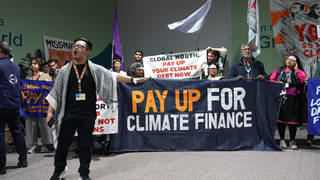
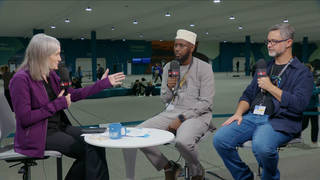
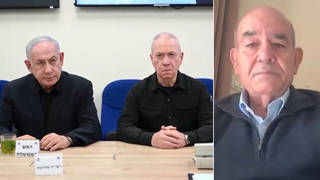
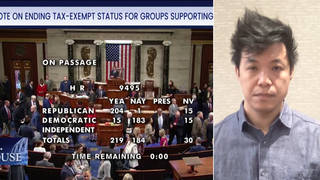
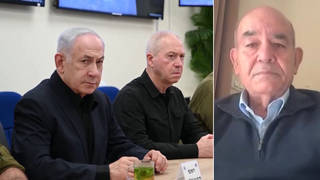




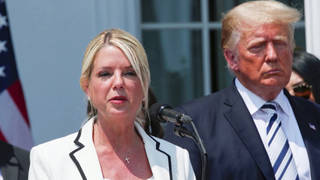
Media Options